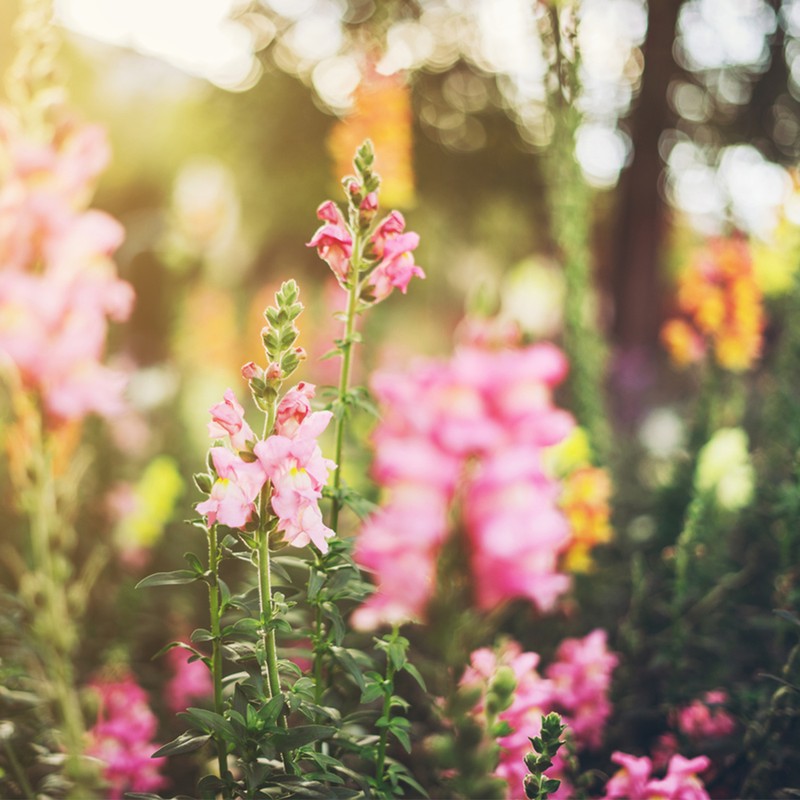What To Plant In Your Garden Now
TRY AND PLAN WHERE YOU CAN
“We're in between the blooms of early spring and those of early summer at the moment,” explains Alice Vincent of @noughticulture and author of Rootbound, Rewilding a Life. “But the supermarkets are full of annuals that can give your pots and borders a pop of colour and, if deadheaded, will keep going through the next few months.” Dianthus, pelargoniums, lobelia and erigeron can all be started now, and work in pots or borders. “Now is a good time to get into small perennials,” adds Alice. “Heuchera, tiarella, hardy geraniums, ferns and lamium – all work in shadier gardens, while sedums and other low-maintenance plants will grow better in the summer months.”
If you want to create colour in a border, it's not too late to order seedlings of hardy annuals like sweet peas – they’re cost-effective and will reward you with armfuls of frothy blooms. “At the school, we teach our students to plan first and buy second,” explains Caroline Tatham, principal of Cotswold Gardening School. “The autumn is the best time to plant, when nature is on your side with all that rain.” Finally, for results you can enjoy this season, Caroline advises going for a quick fix now, before planning more carefully for next year. “It will save you time and money in the long run and reward you with earlier borders,” she says.
Tip: You can't go wrong with hardy geraniums, while small plants bought now will soon bulk up into impressive specimens.
PLANT UP CONTAINERS TO INTRODUCE COLOUR
“Containers are always a great way to create instant impact – and, if you hurry, you can snap up the last of the dahlia tubers now. I love the pretty white daisies of erigeron karvinskianus or Mexican fleabane,” advises Caroline. These will tolerate neglectful watering but do need plenty of light. “Petunias and pansies are a classic choice for containers and I personally love lavender – go for a dwarf variety like Imperial Gem that will enjoy the full sun.” Place a pair either side of a doorway or gate to be drenched in scent when they are in flower, and remember containers aren’t just for patios and balconies. “If you have bare patches in the border, place a pot or two in there. As all the other plants grow up around it, no one will be any wiser,” says Caroline.
Tip: Ferns offer architectural form for shady containers and work well with contrasting smooth and shiny bergenias or elephant's ears.
TAKE THE TIME TO CARE AND NURTURE
Flowering annuals will enjoy the sunniest spots, as long as there’s regular watering. “Until we get into proper summer they won't need watering much more than once a week without rainfall,” explains Alice. “But plants in pots are more thirsty, so keep checking the soil and if it's dry beneath the top two inches, give it a good soaking.” With regards to pruning, remember to remove any faded blooms to encourage new ones to grow, including any crispy leaves. “With pest control, I'm an organic gardener and I urge you not to use chemicals – wipe aphids off with a damp cloth, or spray with a mixture of water with some dish soap.”
Also, remember to do your research to know when, how and where to plant. Luckily, many seed packets and seedlings come with useful instructions. “Sweet peas need lots of water and require some support – a wigwag of bamboo canes is ideal,” Caroline says. “They only live for one year – they live fast and die young in order to be replaced by other plants, which will mature into the vacant space.” Ferns, bergenias and erigerons are also perennials (meaning they live for many years) and all are relatively low maintenance. “Cut your lavender to 8in on the 8th of August (8, 8, 8) so it’s easy to remember. You’ll end up with a neat, evergreen shape in the winter and fresh blooms in the spring,” Caroline says.
Tip: Just like humans, the best defence for disease in plants is a healthy immune system, so keep them well watered and fed.
ATTRACT WILDLIFE TO YOUR GARDEN
If you want to encourage wildlife into your garden, you need to offer three things – food, water and shelter. “Insects will enjoy nectar that is easy to reach – so avoid double and overbred flower shapes,” Caroline says. “Go for simple daisy-like flowers – like echinacea or coneflowers – with nectar which is easy for insects to reach.”
“If you have any flowering weeds in your garden, a lot of these have their own inherent beauty and will be adored by the bees,” says Alice. “Otherwise, lavender, foxgloves, sedum, umbellifer plants and generally letting your lawn grow are all good ways to encourage wildlife.” To provide shelter, consider leaving perennials to stand over the winter so insects have somewhere to hibernate. Chose architectural forms like grasses so you can enjoy their frosty seed heads, too.
Tip: The RHS has a useful initiative on their website called Plants for Pollinators with lots more in-depth advice.
For more information:
Cotswold Gardening School offers three online courses on planting and garden design. When the lockdown lifts they plan to resume day courses, as well as professional tuition.
Visit CotswoldGardeningSchool.co.uk
Follow Alice Vincent at @noughticulture
Rootbound, Rewilding a Life is available now at Waterstones.com
DISCLAIMER: We endeavour to always credit the correct original source of every image we use. If you think a credit may be incorrect, please contact us at info@sheerluxe.com.


